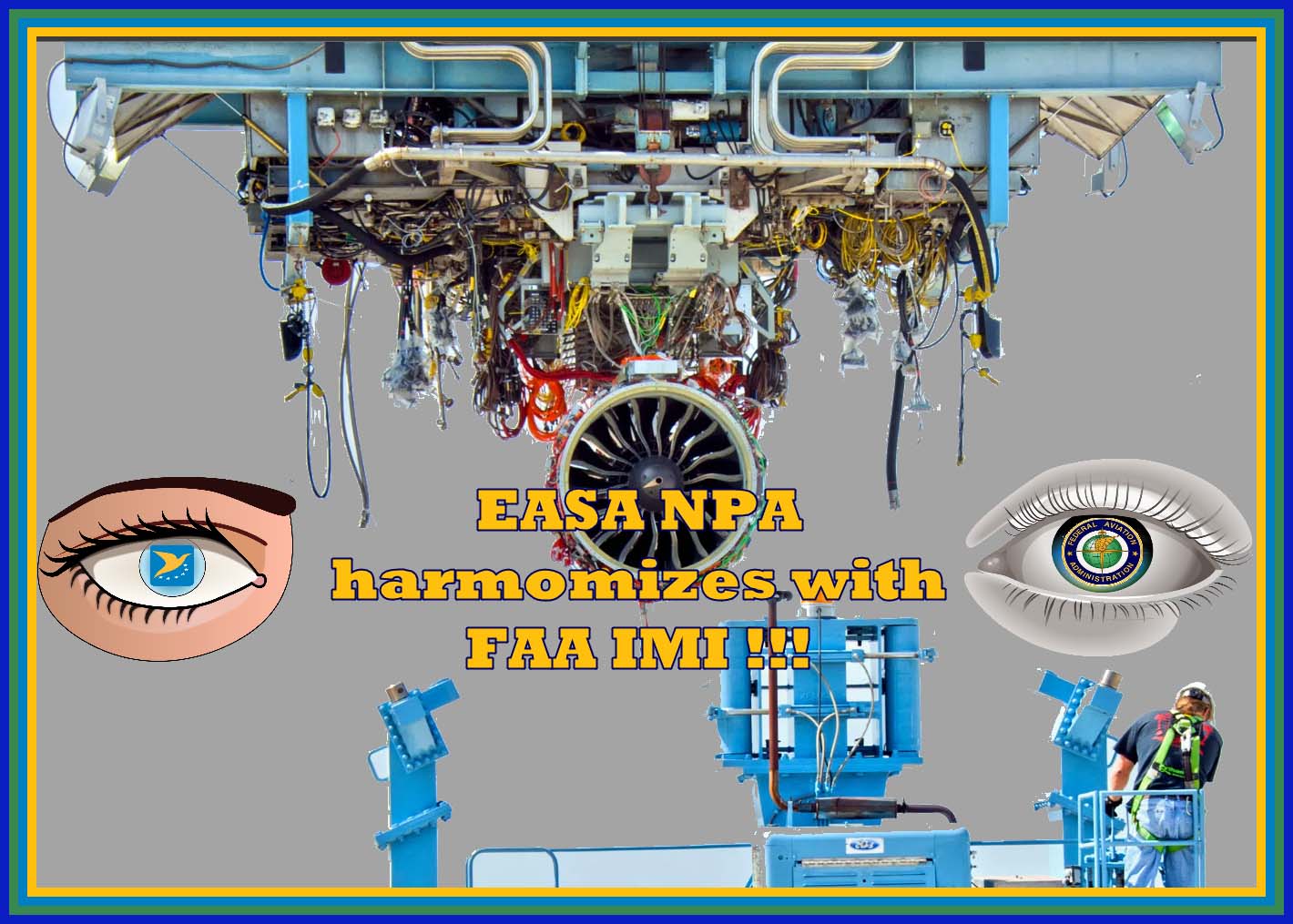EASA and FAA will now eye turbine endurance with the same test

AeroTime, as usual, provides an excellent technical analysis of EASA Notice of Proposed Amendment 2023-06, “Turbine-engine endurance and initial maintenance programme testing, and substantiation of piston-engine time between overhauls or replacements”. The European Union aviation safety organization explained the purpose of this change:
· “upgrade the turbine engine endurance test specifications to take into account modern engine design characteristics;
· improve the level of confidence in the robustness of turbine engine designs prior to entry into service, as well as, in some cases, the definition of initial maintenance inspection (IMI) intervals;
· ensure that EASA exercises oversight of the IMI tests and benefits from the resulting knowledge;
· ensure the robust and harmonised substantiation of the TBO and of the maintenance programmes for piston engines; and
· ENSURE THE GREATEST POSSIBLE HARMONISATION WITH THE RELATED FAA REGULATIONS AND CERTIFICATION POLICIES.”
EASA is harmonizing with an existing FAA IMI test for turbine engines in the course of their airworthiness proof. Several recent powerplants, having met all of the 14 CFR Part 33 requirements, failed during initial operations. As a result of this trend, the Aerospace, Security and Defence Industries Association of Europe (ASD) and the USA-based Aerospace Industries Association (AIA) plus the Aviation Rulemaking Advisory Committee (ARAC) Engine Harmonization Working Group (EHWG) were queried as to what might be a more representative measure of the engines performance over their introduction and beyond. An initial maintenance inspection (IMI) test has been a requirement of the FAA’s Part 33 (refer to 14 CFR § 33.90) for many years while not included in European (JAA and EASA) specifications. NPA 2023-06 proposes to incorporate this advanced test.
Two additional comments:
· Thoughthe change is totally justified, its issuance barely precedes the introduction of some very innovative powerplants including models using hydrogen. The engineers may be challenged by these more exacting test parameters.
· While many still invoke the FAA as THE GOLD STANDARD, one might have referred to their European counterparts, EASA, as THE QUICKSILVER STANDARD. The bureaucrats of Brussels seem to be able to move changes faster through their NPA process than their DC[i] colleagues through the APA’s NPRM hoops. EASA acknowledges that it is harmonizing with an FAA existing airworthiness criterion.
A global set of aircraft certification standards is a goal in the tradition of the Chicago Convention. Europe and North America are diminishing in their domination of international aeronautical engineering and thus, a more uniform measure of airworthiness is critical to the safety of passengers whose travels will increasingly utilize the airplanes manufactured from more nations.
EASA proposes new engine certification regulations to reduce engine failures
The European Union Aviation Safety Agency (EASA) has published a Notice of Proposed Amendment (NPA) to modernize aircraft engine certification rules.
EASA has highlighted three main issues with the current regulations:
· An outdated engine endurance test
· LACK OF HARMONIZATION BETWEEN IT AND THE UNITED STATES (US) FEDERAL AVIATION ADMINISTRATION (FAA) ON THE INITIAL MAINTENANCE INSPECTION (IMI) TEST
· Substantiation of piston-engine time between overhaul (TBO) or time between replacements (TBR)
60-year aircraft engine endurance test
According to EASA, the engine endurance test, which is required for propulsion systems to be certified, proves that an engine can sustain “a minimum level of engine operability and durability within, and including, the approved engine ratings and operating limitations”.
However, the test was first conceived 60 years ago, when very different engine designs were used on commercial aircraft. For reference, the first commercial aircraft to use a jet engine, the de Havilland Comet, took off on its first revenue flight in 1952, more than 70 years ago.
“The issues with the requirement arise due to the test running conditions becoming harder to achieve as engine designs and operations have evolved to meet the performance demands of the modern air transport market,” argues EASA, adding that engine manufacturers had to incorporate modifications just to meet the conditions of the test. As a result, though, “experience with more recent engine certification projects has highlighted the complexity of such substantiations, considering the modifications required”, making the AUTHORITY DOUBT THE REPRESENTATIVENESS OF THE TEST.
EASA assessed that some aircraft engines have failed shortly after beginning commercial flights, requiring urgent actions via Airworthiness Directives (AD) to rectify the issue.
“The root cause of such failures may have been identified during the engine endurance test if the test conditions and the engine configuration had been more representative,” EASA stated. Even if no engine failures have been directly associated with fatalities, the agency and industry “identified the need to ensure a more representative test and thereby increase the probability of detecting such issues before entry into service of the engine”.
Harmonizing certification with the FAA
The European regulator also highlighted that while the FAA has mandated an initial maintenance inspection (IMI) test, EASA has not.
“THERE IS, THEREFORE, A LACK OF HARMONISATION BETWEEN EASA AND THE FAA ON THIS SUBJECT,” noted EASA.
It is considered an “important element” of the certification process, especially since it can reveal design-related issues while an engine maker is in the process of getting approval for its product that no other certification tests can showcase. As such, EASA considers that “potential unsafe conditions may develop once the engine enters into service”.
According to EASA, the Design & Manufacturing Technical Committee (DM.TEC) provided “some comments” that were “supportive” of the proposals. “In particular, the introduction of an alternate endurance test in CS-E [certification specifications (CSs) and acceptable means of compliance (AMC) for engines – ed. note] has been asked by engine manufacturers for years,” stated the regulator.
[i] With the extensive use of remote work, many FAAers are working from HOME; so, the acronym DMV may be more apt.